The Canberra Carousel Organ
Gebruder Bruder Elite Apollo Orchestra
No. 5073

From Carousel Organ Restoration Group Inc. Newsletter April 06:
For further information please go to their webste http://members.iinet.com.au/~mydav/bruder.htm
By David Kerr
In The Beginning
The Organ first saw the light of day about 1911. It was built by the firm of Gebruder Bruder (literally the Brother Brothers) of Waldkirch in the Black Forest, Germany and was purchased to accompany a Merry-Go-Round (carousel) designed and constructed in 1914 by Herbert Thomson, the designer of Australia’s first steam car in his Armadale (Victoria) workshop in 1896. The organ is of the larger variety of fairground organs, consisting of some 247 pipes, a 22 note Glockenspiel, as well as various percussion instruments, all of which are played automatically using punched cardboard “books”, in much the same way as a pianola (player piano). The keying system is of the “keyless” variety, comprising 69 tracks. The organ was known as the “Apollo” after the God of the Sun from Greek mythology.
The Carousel
It was the largest portable steam riding gallery seen in Australia, with a mechanical system allowing it to carry fifty tons without noise or vibration. It carried forty-eight ornately carved horses galloping four abreast; a steam-engine of brass against a highly decorative mirrored background; twisted brass upright bars and an elaborate organ with moving mechanical figures. The carved wooden horses, imported from Germany were impaled on brass bars made in Scotland. They were brightly painted with coloured glass on their harnesses and gargoyles on the rear of their saddles. The horses were all named after popular race horses of the time. The carousel and organ were installed on the Esplanade of the Melbourne bay side suburb of St. Kilda adjacent to Luna Park, the recently built (December, 1912) amusement park modelled on a similar American establishment at Coney Island. The carousel travelled the rural “show circuit” during the winter months for a number of years, before being located permanently on the Esplanade at St.Kilda. Anton Weniger, a German immigrant ran the carousel until he relinquished it to William Kelly after about fifty soldiers arrived at the Esplanade in January 1916 during the First World War and attacked Weniger’s Riding Gallery because he was German. (from “St.Kilda - The Show Goes On” by Anne Longmire, 1983 ). It is likely that the organ facade was damaged at this time since the maker’s name (Gebruder Bruder) was emblazoned on it above the Glockenspiel. The board bearing the maker’s name and the wings, which carried the drums, are missing from those parts of the facade that still exist.
St Kilda was the entertainment hub of Melbourne for the next forty years with a plethora of amusements at Luna Park, the Fun Fair and the nearby dance halls, movie houses and theatres. The carousel was popular with new arrivals from Europe after the second world war since it reminded them of similar facilities in Europe.
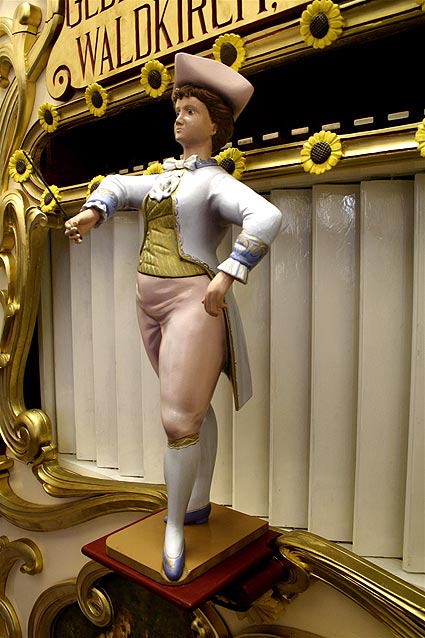
Decline and Fall
Harry Hall-Kenny of McDonald’s Carnival Amusements which owned the largest carnival plant in Australia, took over the carousel and other facilities in 1958. This was the time of the introduction of Television which had a major impact on the Fun Fair, already suffering decline due the age of the facility and lack of preventative maintenance.
The pressures of urban development and the need for improved traffic flow resulted in the disbandment of the St.Kilda Foreshores Committee of the St.Kilda City Council, in 1973. The Committee was responsible for the administration of the land upon which the carousel and other amusements were situated. The land use was thus changed resulting in closure of the Fun Fair, including the carousel which had operated on and off since its inception. The executors of the estate of the deceased owner, Harry Hall-Kenny, put the merry-go-round up for auction on 28 September 1973, and advertised it as “Australia’s Most Famous Merry”, “One of few such merry-go-rounds outside Europe”, and “the peer” of Australia’s mechanical amusements.
The Melbourne Steam Traction club and Knox City Council raised $39,000 to purchase the merry-go-round for a proposed “historical complex” at the City of Knox, but could not outbid the recreation division of the Department of the Capital Territory, which purchased the merry-go-round at $40,000.
Prior to the auction, the organ had been in storage for some twenty years, awaiting repairs. During that period, it suffered a great deal of damage. The advice to the then Chairman of the Canberra Advisory Council, Mr. Jim Pead, was that it was beyond repair and should be disposed of. Fortunately, Mr. Pead sought a second opinion from Canberra organ enthusiast, Mr. Terry Lloyd, who travelled to Melbourne to inspect the organ. His advice was that, despite it’s deteriorated condition, the organ should be retained and brought to Canberra, in the hope that some day this piece of history might be resurrected and returned to it’s original role, that of providing a type of music that was was part of the early culture in many parts of Europe at the turn of last century.
When inspected at St.Kilda, it was found that most of the case and pipe chests were riddled with borers. Many pipes were broken, music books had been subjected to water damage, and most of the dismantled components were lying scattered in a room adjacent to the merry-go-round room. All of the original percussion instruments, the three original automated figurines, as well as the cast drive wheel, were missing.
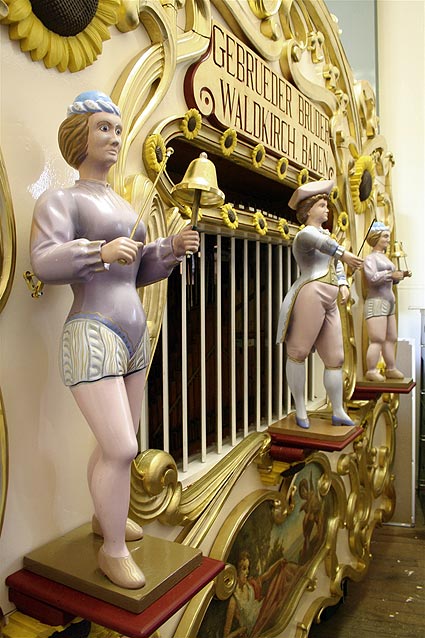
The Resurrection
After the organ arrived in Canberra, a small group of volunteers was formed to undertake the re-building of the organ on behalf of the Government. The group was known as “The Carousel Organ Restoration Group” (CORG). The task facing them was a mammoth one. On inspection it was found that the glockenspiel had gone missing either before or during transit. The organ was completely unplayable since most of the chests were riddled with woodworm holes. Some of the pipes were missing but most appeared to be in reasonable order. With the financial assistance of a grant from the then Canberra firm, J. B.Young, the team set about to rebuild the case and most of the chests, using the old ones as patterns. Being part-time volunteers, the rebuilding task took ten years. The instrument first played in 1983, using the original unrestored music books, most of which were in broken sections and water damaged. When the initial restoration was nearing completion, CORG decided it was time to enlist professional help. The organ was sent to the highly respected Melbourne pipe organ firm, Laurie Pipe Organs, who carried out final regulation of the wind supply, re-construction of the broken pipes and the fine-tuning of all pipe work. When the organ returned to Canberra in 1987 it was as close to it’s original condition and playing ability as was possible, albeit without the facade. It is worthwhile quoting the appraisal of CORG’s work by the principal of the Melbourne organ firm, Mr.Steve Laurie, in a report to the then Department of Territories:- “Messrs. Terry Lloyd, Brian Stoneman, Bert Taylor and the Carousel Organ Restoration Group must be accorded the highest praise for having achieved the almost impossible task of bringing the instrument to its present workable condition. This was despite the fact that many parts were missing and others decayed by rot and borer to a point almost beyond recognition.”
This major achievement was undertaken with limited resources and funding, a credit to the dedication of the members of CORG.
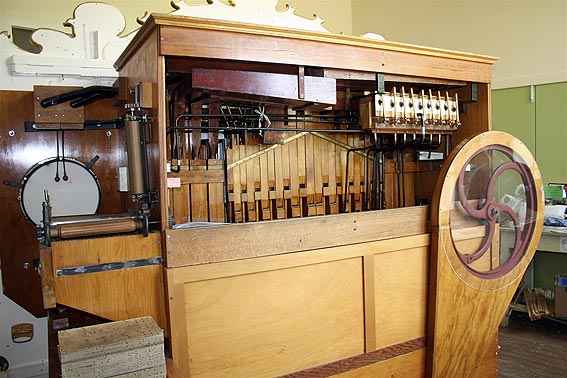
The Continuing Challenge
What still remained to be done before the instrument could be presented to the general public included the mounting on a purpose-built trailer, the reconstruction of the original facade, the carving of three suitable figurines and the recovery of the old music. Having the organ on a trailer would allow it to be taken to various locations around the City. On occasions, it could be placed adjacent to the carousel so that the original association that the two had during the St. Kilda years could be re-established.
In the longer term, the old music would be transferred to new card stock, a quantity of which has been imported from Europe in preparation for that task. Three new figurines were commissioned from our wood carver, Graham Whitehead, and have now been completed .For the first time since coming to Canberra, the organ has a permanent home at the Ainslie Arts Centre.The Continuing task of restoration is being undertaken by CORG with the support of the Australian Capital Territory Government Division of Urban Services Heritage Unit which has ownership of the instrument. The Heritage unit provides funding in the form of occasional grants and material aid to undertake specific tasks.
The specification of the organ is very similar to the Wurlitzer 165 band organ in the USA, which was shipped from Germany without the key frame. A paper roll keyframe was installed on those, which worked on suction, not pressure as the Bruder book style does. Another major difference between the Wurlitzer and this Bruder is the placement of the Glockenspiel which is mounted horizontally above the organ on ours but on the Wurlitzer it is mounted with the bars vertical, low down on the front. This latter arrangement is common amongst fairground organs. This has major implications on the facade since the Glock speaks through an aperture in the front of the Wurlitzer facade which would make no sense on a facade for our Bruder. Another major difference is the placement of the figurines. The Wurlitzer had only two that did not appear to be animated, our Bruder had three, all animated.
The remains of the facade, which accompanied the carousel from Melbourne, were partially destroyed when it fell into the rotating carousel shortly after installation in Canberra. These remaining parts were attached to a board located on the carousel and were unavailable to the team so it was decided to construct a façade similar to the Wurlitzer, since it is the only instrument in existence of similar specification. That was until the carousel underwent a major refit to bring it into line with modern safety requirements when the remaining carvings were made available to the team.
Once the carvings became available, it became necessary to design a facade to suit, since the carvings bore little resemblance to those on the Wurlitzer. There seemed to be no Bruders of that vintage surviving anywhere in the world from which we could gain some idea of the original facade’s appearance. The CORG president, Bert Taylor, made contact with Patricia Mullins, Co-ordinator of the Melbourne, Australia Luna Park Merry-go-round Gallopers Restoration Project who advised that Fred Dahlinger Jr. Director of Historic Resources and Facilities at the Circus World Museum in Wisconsin USA might be able to help with information on the façade. Amazingly, he came up with a photograph of the Bruder before it was shipped from Germany. The photo was supplied to him by Stephan Fleck of Paul Fleck & Sons of Waldkirch, Germany, the home town of our Bruder. Having a photograph of the façade meant that work could commence on its reconstruction.
One of the problems which became apparent with this new acquisition is that the figurines we have had carved are completely different to those depicted in the photograph. They were modelled on traditional fairground organ figurines. The bandmaster was based on a figurine supplied by Craig Robson who has an extensive collection of fairground organs, as well as a vintage carousel and a showman’s steam engine, in Sydney, Australia. The original figurines comprised two partly clad female bellringers and a female bandmistress so the challenge now becomes to find a buyer for our existing figurines so that we can commission the carving of reproductions of the original figurines.
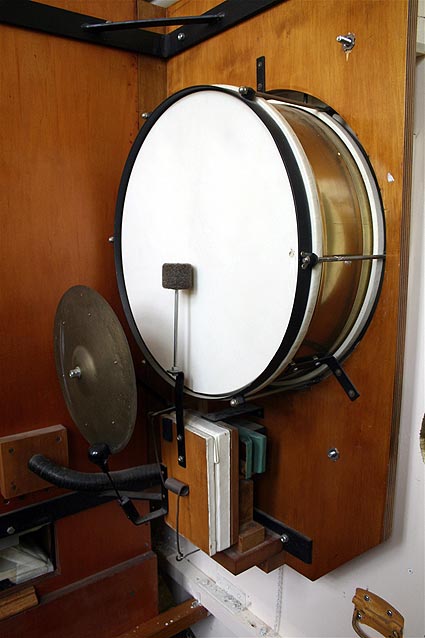
The Specification
|
Bar No. 2 4 6 8 10 12 14 16 18 20 22 24 26 28 30 32 34 36 38 40 42 44 46 48 50 52 54 56 58 60 62 64 66 68 69 67 65 63 61 59 57 55 53 51 49 47 45 43 41 39 37 35 33 31 29 27 25 23 21 19 17 15 13 11 9 7 5 3 1 |
Register Percussion Percussion Bass (Low) Bass (Low) Bass (Low) Jalousie Bass Trompette Reed Melody (low) Reed Melody (Low) Reed Melody (Low) Reed Melody (Low) Reed Melody (Low) Reed Melody (Low) Reed Melody (Low) Reed Melody (Low) Violin Forte Piccolo Mixture Main Melody (High) Main Melody (High) Main Melody (High) Main Melody (High) Main Melody (High) Main Melody (High) Main Melody (High) Main Melody (High) Main Melody (High) Main Melody (High) B Main Melody (High) Counter Melody (High) Counter Melody (High) Counter Melody (High) Counter Melody (High) Counter Melody (High) Counter Melody (High) Counter Melody (Low) Counter Melody (High) Counter Melody (High) Counter Melody (High) Counter Melody (High) Counter Melody (High) Main Melody (Low) Main Melody (High) Main Melody (High) Main Melody (High) Main Melody (High) Main Melody (High) Main Melody (High) Main Melody (High) Main Melody (High) Main Melody (High) Main Melody (High) Violin Piano Glockenspiel Reed Melody (High) Reed Melody (Low) Reed Melody (Low) Reed Melody (Low) Reed Melody (Low) Reed Melody (Low) Reed Melody (Low) Reed Melody (Low) General Cancel Contra Bass Bass (High) Bass (Low) Bass (Low) Bass (Low) Percussion Percussion |
Chest No. 1 2 3 4 5 6 7 8 9 10 11 12 13 14 15 16 17 18 19 20 21 22 23 24 25 26 27 28 29 30 31 32 33 34 35 36 37 38 39 40 41 42 43 44 45 46 47 48 49 50 51 52 53 54 55 56 57 58 59 60 61 62 63 64 65 66 67 68 69 |
Note/operation Right Figurine Bass Drum/ Centre figurine A C E Swell Shutters Bass Trumpet/Horn E F# G# B C D E F# Violin Forte Piccolo/Mixture F D C B G# F# E D C B G# F# E D C E G# G A H C# D# F G A H C# D# F G A H C# E Violin/Piano/Vox Celeste Glockenspiel on G F D# C# H A G F Declanche (cancel) Contra Bass F D H (bass under) G (bass under) Snare Drum Left Figurine |
Hole dia=2.8mm on reader bar at 4.17 mm centres, 3.5 mm on card,
spacing at 4.17 mm centers, travel speed 76 to 78 mm/sec
The following table lists the various registers
|
Stopped Flute Principal Stopped Flute Principal Trompeten Clarinet Principal Trombone Violin Flute Violin Octave Principal Piccolo Violin Viol Celesta Metal Bars |
10-2/3' 7 Pipes (under) 5-1/3' 7 Pipes (under) 5-1/3" 12 Pipes 2-2/3 12 Pipes 2-3/5' 16 Pipes 2-3/5' 16 Pipes 2-3/5' 16 Pipes 10-2/3' 7 Pipes 2-2/3' 22 Pipes 2-2/3' 22 Pipes 1-1/3' 22 Pipes 2-2/3' 22 Pipes 1-1/3 22 Pipes 2-2/3' 22 Pipes 2-2/3' 22 Pipes 10-2/3' 22 Bars |

Facade Reconstruction
The reconstruction of the facade seemed to be a mammoth one. The backboard was no problem but the team had no skills for carving the scrollwork. Fortunately, one of the team is a wood craftsman and he enlisted two other wood carvers from the local Woodcraft Guild to undertake this task. The contribution by Keith and Brian has been inestimable, the project could not have proceeded without their massive contribution.
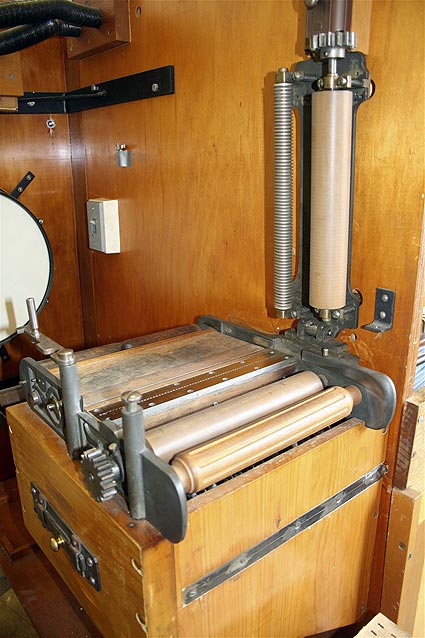 |
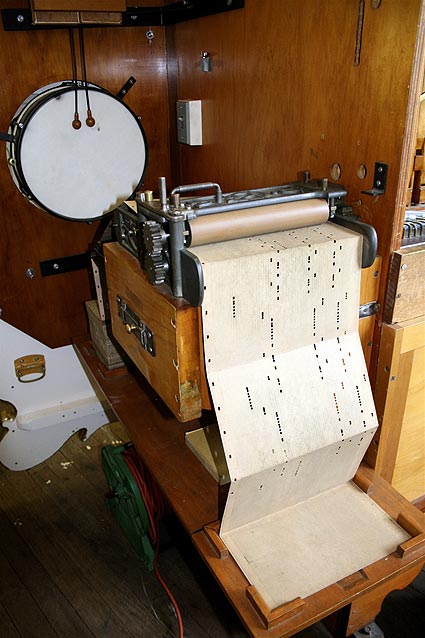 |
Acknowledgement
The historical information contained in this article was obtained from Anne Longmire’s book “St Kilda The Show Goes On. The History of St. Kilda Vol 3, 1930 to July 1983” which gives a facinating account of the physical and social changes over the years. Much of the information on the organ since coming to Canberra was supplied by Terry Lloyd, original convenor of CORG. Mention must also be made of the support given to CORG by Susan Bell of the ACT heritage Unit. Information on the Wurlitzer 165 was from an article by Jeff Alterman on 65 and 69 key Gebruder Bruder organs in America published on the net in the Mecanicaal Music Archives .
David Kerr
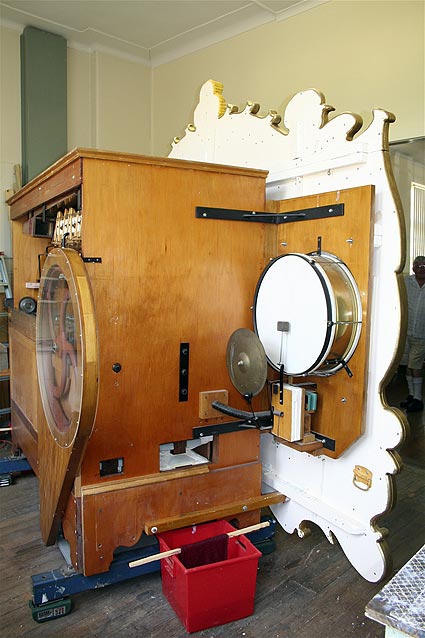
Photos: Trevor Bunning Dec 2006